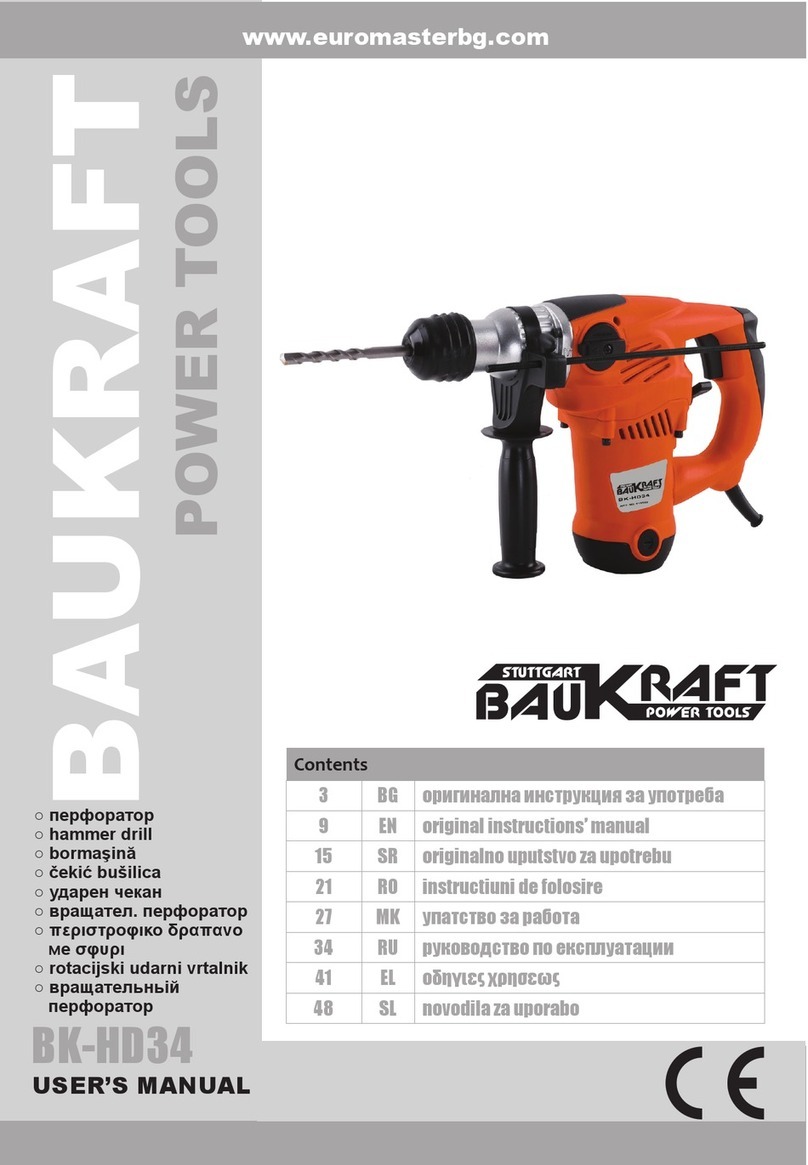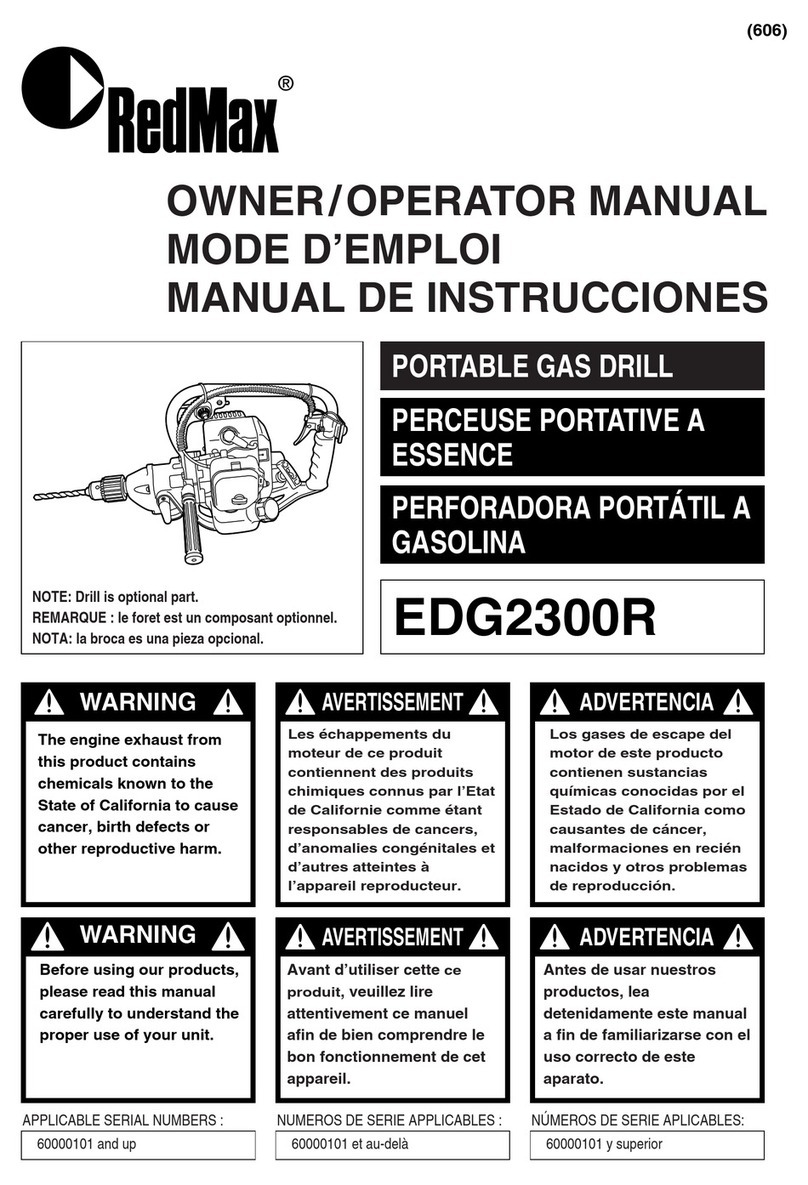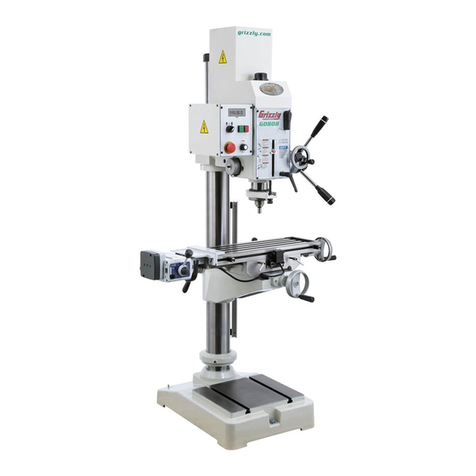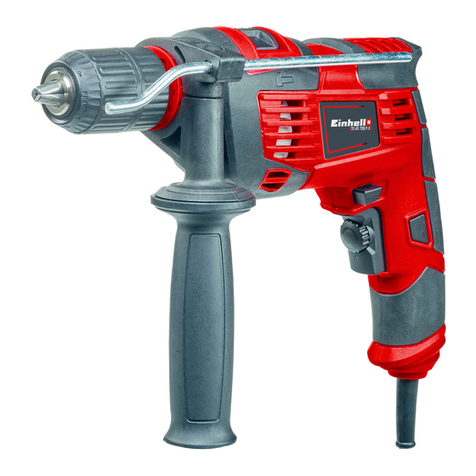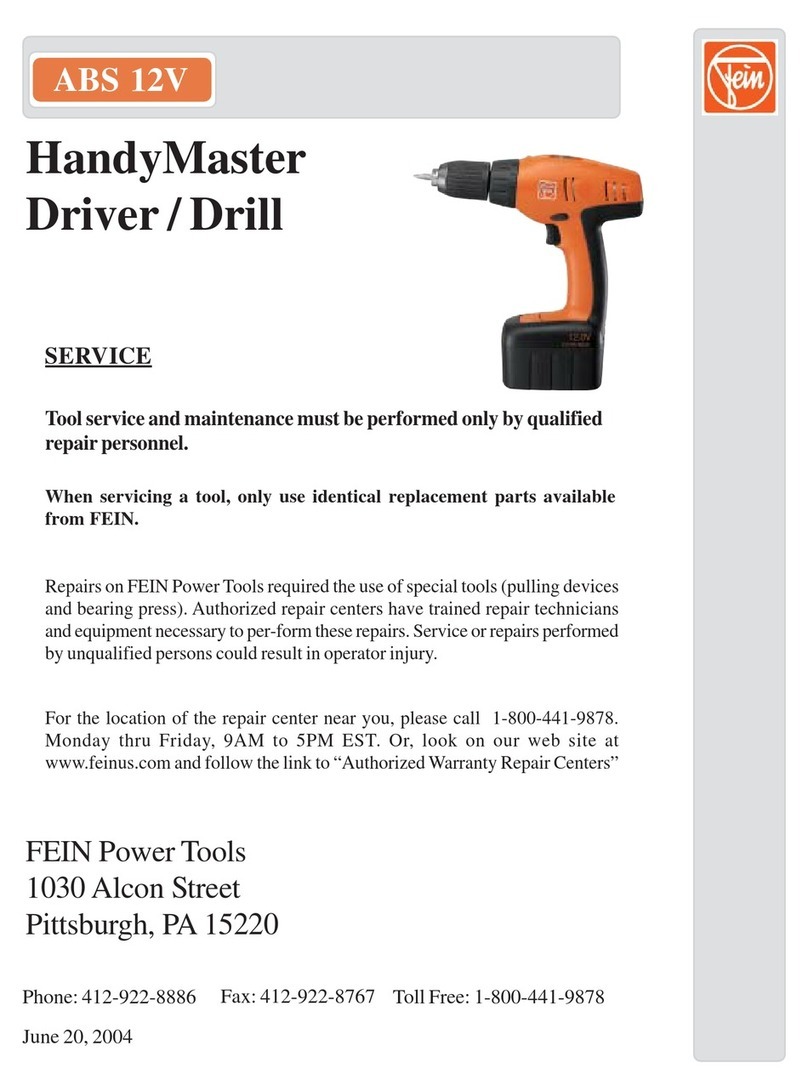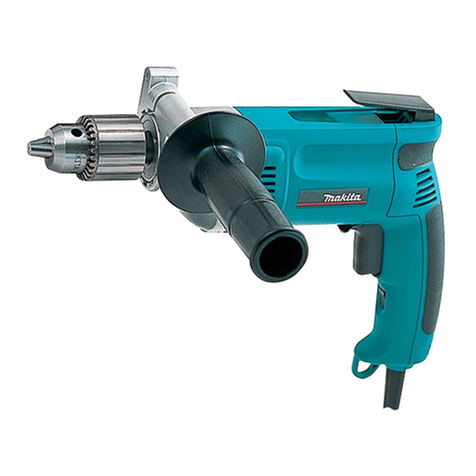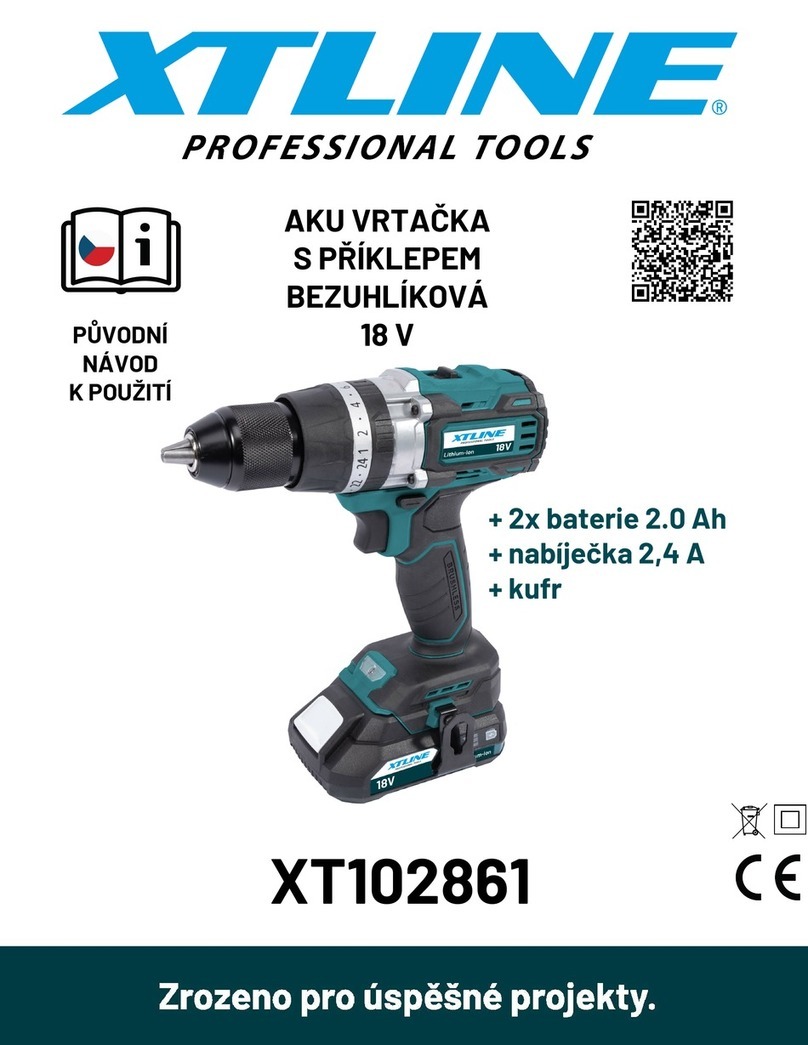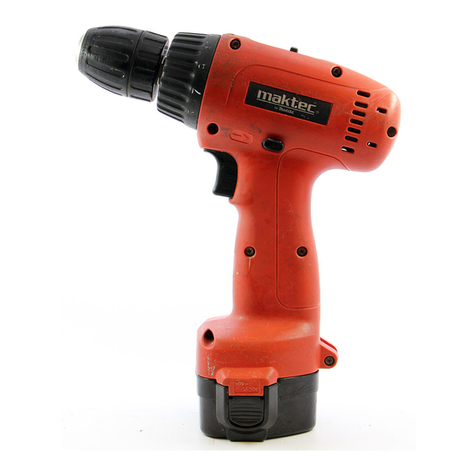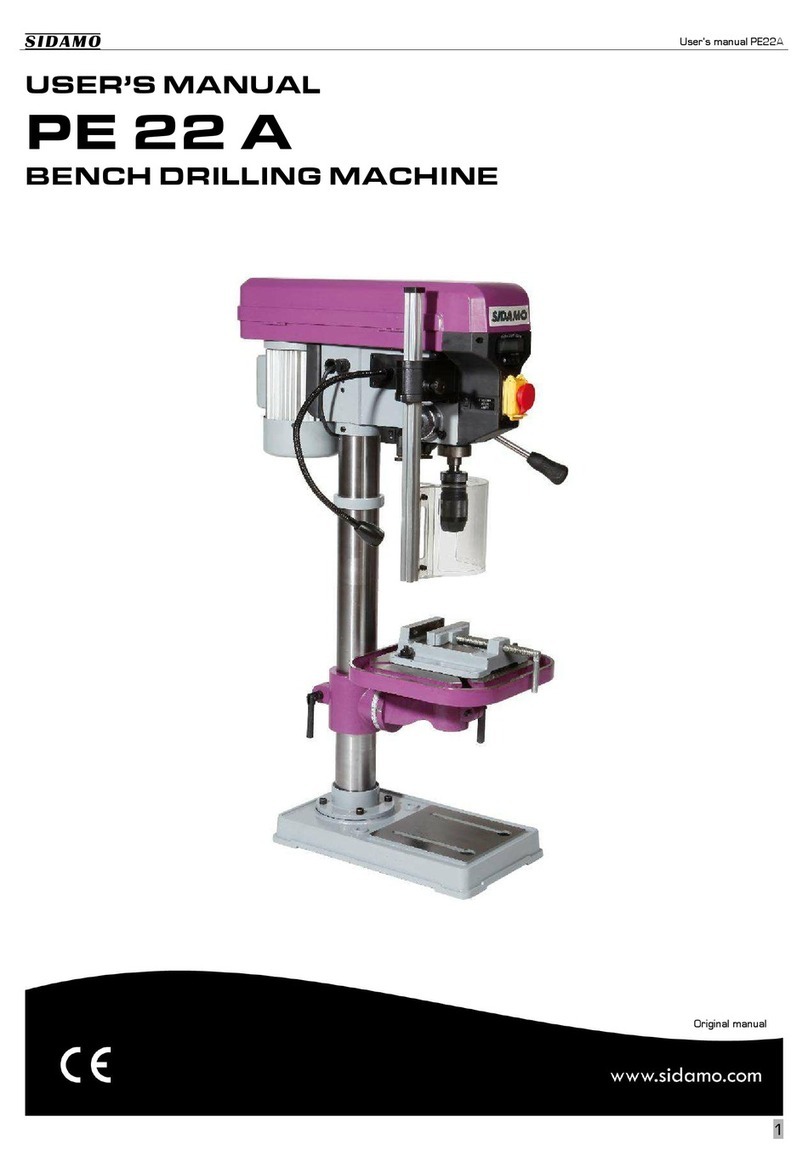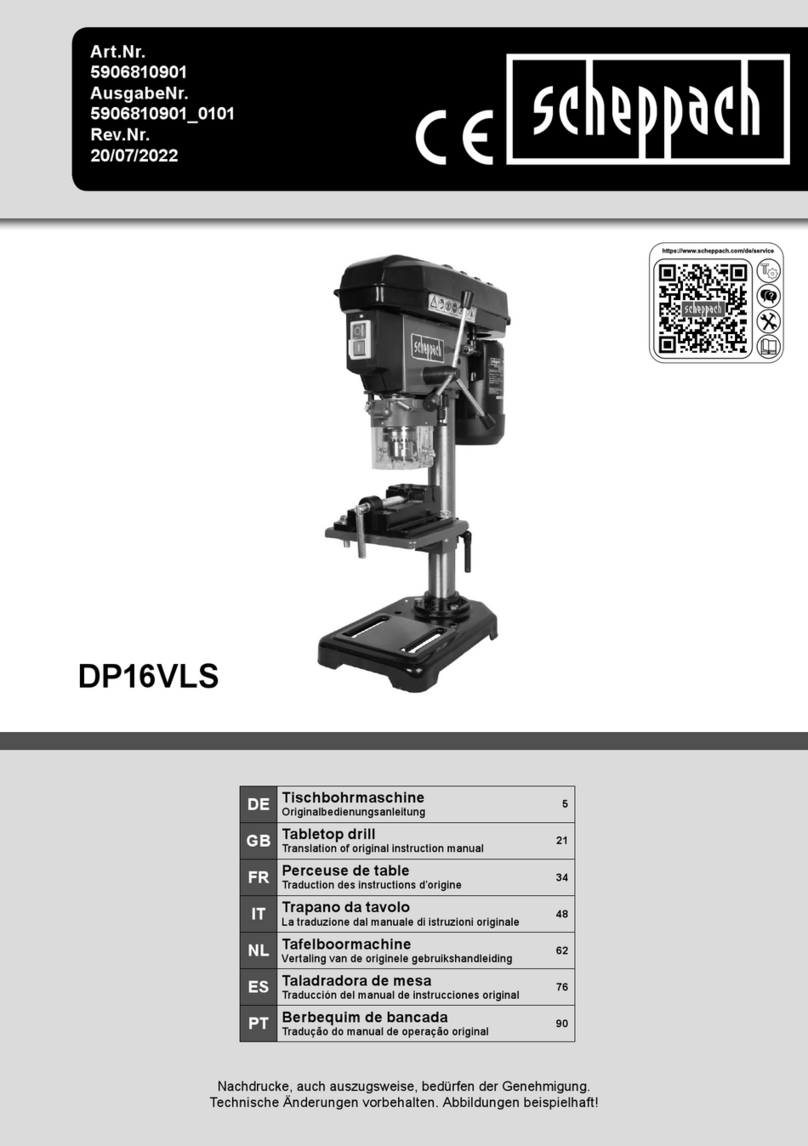GreenTech WTLD018-06 User manual

02325010
WTLD018-06
Model / Modèle :
CORDLESS IMPACT DRIVER & DRILL
P. 14
P. 2
TOURNEVIS SANS FIL ET PERCEUSE
800-832-7168

1 Drive Bit Retaining Ring
2 LED Worklight
3 Battery Release Button
4 Variable Speed Trigger
5 Forward/ Reverse Lever
6 Battery 18 V
1.Manchon
2.Lampe de travail à DEL
3.Bouton de déverrouillage des piles
4.Gâchette à vitesse variable
5.Levier marche avant/marche arrière
6.Pile 18 V
TABLE OF CONTENTS
ENGLISH
2

1. Keyless chuck
2. Handle
3.Variable speed trigger with electric brake
4. Forward/lock/reverse lever
5. 18 V Battery
6. LED battery level indicator
7. Battery release button
8. Torque adjustment collar
9. Gearbox speed selector
10. Charging adaptor
11. LED charging indicator
12. Spirit level
13. LED light
14 Rope
15 Screw driver bit 2 pcs
1. Mandrin sans clé
On rear/l'arrière
2. Poignée
3. Gâchette à vitesse variable avec
frein électrique
4. Levier marche avant/verrouillé/marche
arrière
5. Pile 18 V
6. Indicateur de pile à DEL
7. Bouton de déverrouillage des piles
8. Bague de réglage de couple
9. Sélecteur de vitesses
10. Adaptateur pour chargeur
11. Indicateur de charge à DEL
12. Niveau à bulle
13. Lumière à DEL
14. Corde
15. Embout pour tournevis, 2 pièces
3
ENGLISH

WARNING! Before using the product for the first time, please make sure you
read these operating instructions! Here you will find information about how to
use the product safely and ensure its long service life.
TABLE OF CONTENTS
• Description of symbols
• Technical data
• General instructions
• Additional safety warnings
• Application
• Assembly
• Operation
• Maintenance
• Warranty
.....................................................................................
.................................................................................................
.........................................................................................
...............................................................................
........................................................................................................
..........................................................................................................
.........................................................................................................
.....................................................................................................
...........................................................................................................
p.4
p.5
p.6
p.7
p.8
p.9
p.10&11
p.12
p.13
DESCRIPTION OF SYMBOLS
Observe caution and safety notes!
No-load speed.
no
Voltage
V~
Milliamps/Amps/Amp-hours
mA
A/Ah
Protect electrical power tool from moisture!
Safety class II
Please discard or recycle your product and its packaging
according to your municipal bylaws.
DC (current and voltage type)
Drill setting (torque Preselect)
ENGLISH
4

5
DC 18 V
Drill: n/a; driver: 0-3200/min
Drill: 3/8" ; driver: 1/4"
Drill: 30 Nm; driver:130 Nm
Model number
02325010
Product code
Rated voltage
No-load speed
Impact frequency
Max. torque
Rated chuck diameter
Drill: 0-400/0-1200 RPM; driver: 0-2000/min
Read all safety warnings and all instructions. Failure to follow the warnings and instructions may result in electric
shock, fire and/or serious injury.
Warning! A battery-operated tool with integral batteries or a separate battery pack must be recharged only with the
specific charger for the battery. A charger that may be suitable for one type of battery may create a risk of fire when used
with another battery.
1. Avoid accidental starting. Make sure the switch is in the locked OFF position before inserting the battery pack.
Carrying a tool with your finger on the switch or inserting the battery pack into a tool with the switch on invites
accidents.
2. Disconnect the battery pack from the tool or place the switch in the locked OFF position before making any adjustments,
changing accessories, or storing the tool. Such safety measures reduce the risk of starting the tool accidentally.
3. When the battery pack is not in use, keep it away from other metal objects. Read the whole manual carefully and
make sure you know how to switch the
tool OFF, in an emergency, before operating the tool.
Save these instructions and other documents supplied
with this tool for future reference.
WARNING
!
TECHNICAL DATA
ENGLISH
WTLD018-06

6
Work area safety
1. Keep work area clean and well lit. Cluttered or dark
areas invite accidents.
2. Do not operate power tools in explosive
atmospheres, such as in the presence of flammable
liquids, gases or dust. Power tools create sparks
which may ignite the dust or fumes.
3. Keep children and bystanders away while
operating a power tool. Distractions can cause you
to lose control.
Power tool use and care
1. Do not force the power tool. Use the power tool
correctly for your application.
The correct use will
do the job better and safer at the rate for which it was
designed.
2. Do not use the power tool if the switch can't turn
the tool
on and off. Any power tool that cannot be
controlled
with the switch is dangerous and must be
repaired.
3. Remove the battery pack from the power tool before
making any adjustments, changing accessories,
or storing power tools. Such preventive safety
measures reduce the risk of starting the power tool
accidentally.
4. Store idle power tools out of the reach of children
and do not allow persons unfamiliar with the
power tool or these instructions to operate the
power tool. Power tools are dangerous in the hands
of untrained users.
5. Maintain power tools. Check for misalignment or
binding of moving parts, breakage of parts and
any other condition that may affect the power tool’s
operation. If damaged, have the power tool repaired
before use. Many accidents are caused by poorly
maintained power tools.
Electrical safety
1. The charger’s plug must match the outlet. Never
modify the plug in any way. Do not use any adapter
plugs with grounded power tools.
Unmodified plugs and matching outlets will reduce
risk of electric shock.
2. Use this battery-operated tool only with its
specifically designated battery pack. The use of
any other batteries may create a risk of fire.
3. Do not expose power tools to rain or wet conditions.
Water entering a power tool will increase the risk of
electric shock.
4. A battery-operated tool with integral batteries or
5. When operating a power tool outdoors, use an
extension cord suitable for outdoor use.
a separate battery pack must be recharged only
with the specified charger for the battery. A charger
that may be suitable for one type of battery may create
a risk of fire when used with another battery.
Use of
a cord suitable for outdoor use reduces the risk of
electric shock.
6. Always use the power tool in conjunction with
a residual circuit breaker device. The use of a
residual circuit breaker device reduces the risk of
electric shock.
Personal safety
1. Stay alert, watch what you are doing and use
common sense when operating a power tool. Do
not use a power tool while you are tired or under
the influence of drugs, alcohol or medication. A
moment of inattention while operating power tools
may result in serious personal injury.
2. Use personal protective equipment.
Always wear
eye protection. Protective equipment such as dust
mask, non-skid safety shoes, hard hat, or hearing
protection used for appropriate conditions will reduce
personal injuries.
3. Prevent unintentional starting. Ensure the switch
is in the off-position before inserting the
battery
pack, picking up or carrying the tool.
GENERAL INSTRUCTIONS
Carrying power tools with your finger on the switch or
recharging power tools that have the switch
on invites
accidents.
4. Remove any adjusting key or wrench before turning
the power tool on. A wrench or a key left attached
to a rotating part of the power tool may result in
personal injury.
5.
Do not overreach. Keep proper footing and balance
at all times.
This enables better control of the power
tool in unexpected situations.
6.
Dress properly. Do not wear loose clothing or
jewelry. Keep your hair, clothing and gloves away
from moving parts. Loose clothes, jewelry or long
hair can be caught in moving parts.
7. If devices are provided for the connection of dust
extraction and collection facilities, ensure these
are
connected and properly used.
Use of dust
collection can reduce dust-related hazards.
ENGLISH

7
Battery tool use and care
1. Recharge your tool's battery only with the charger
specified by the manufacturer. A charger that is
suitable for one type of battery pack may create a
risk of fire when used with another battery pack.
2. Use power tools only with their specifically
designated battery packs. The use of any other
battery packs may create a risk of injury and fire.
3. When battery pack is not in use, keep it away
from metal objects, like paper clips, coins, keys,
nails, screws or other small metal objects, which
can make a connection from one terminal
to another. Shorting the battery terminals together
may cause burns or a fire.
4. Under abusive conditions, liquid may be ejected
from the battery; avoid contact. If contact
accidentally occurs, flush with water. If liquid
contacts eyes, additionally seek medical help.
Liquid ejected from the battery may cause irritation
or burns.
Service
Do not let comfort or familiarity with your tool replace
strict adherence to cordless drill safety rules. If you
use
this power tool unsafely or incorrectly, you can
suffer
serious personal injury.
Have your power tool serviced by a qualified
repair person using only identical replacement
parts. This will ensure that the safety of the power
tool is maintained.
1) Hold tool by insulated gripping surfaces when
performing an operation where the cutting tool
may contact hidden wiring. Contact with a “live”
wire will make exposed metal parts of the tool “live”
and shock the operator.
1. Specific safety rules
1) Before using the charger, read all instructions and
cautionary markings on the charger and battery pack
as well as the instructions on using the battery pack.
2) Only charge your batteries indoors as the charger is
designed for indoor use only.
3) DANGER. If the battery pack is cracked or damaged
in any other way, do not insert it in the charger. There
is a danger of electric shock or electrocution.
4) WARNING. Do not allow any liquid to come into contact
with the charger. There is a danger of electric shock.
5) To allow the battery pack to cool down after charging,
do not place it in a hot environment such as a metal
shed or open trailer left in the sun.
6) The charger is not intended for any use other than
charging the exact type of rechargeable battery pack
as supplied with the charger. Any other use may result
in the risk of fire, electric shock or electrocution.
7) The charger and battery pack supplied with it are
specifically designed to work together. Do not attempt
to charge the battery pack with any other charger than
the one supplied.
2. Important safety instructions for charger and
battery pack
ADDITIONAL SAFETY WARNINGS
6. Use the power tool, accessories and tool bits etc.
in accordance with these instructions, taking into
account the working conditions and the work to
be
performed.
Use of the power tool for operations
7. Use the power tool, accessories and tool bits etc.
in accordance with these instructions and in the
manner intended for the particular type of power
tool, taking into account the working conditions
and the work to be performed.
Use of the power
tool for operations different from intended could
result in a hazardous situation.
different from those intended could result in a
hazardous situation.
2) Be aware that this tool is always in an operating
condition, because it does not have to be plugged
into an electrical outlet.
3) Always be sure you have a firm footing.
4) Be sure no one is below you when using the tool
in high
locations.
5) Hold the tool firmly with both hands.
6) Keep hands away from rotating parts.
7) Do not leave the tool running. Operate the tool
only when hand-held.
8) Do not touch the bit or the work piece immediately
after operation; they may be extremely hot and
could burn your skin.
9) Some material contains chemicals which may be
toxic. Take caution to prevent dust inhalation and
skin contact. Follow material supplier safety data.
ENGLISH

8
1) The battery pack for this tool has been shipped in a
low charge condition. You should charge the battery
pack fully before use.
2) To ensure the longest battery life and best battery
performance, always charge the battery when the air
temperature is between 18-240C (65-750F). Do not
charge the battery pack when the temperature is
below 4ºC (400F),or above 400C (1040C). This is
important. Failure to observe this safety rule could
cause serious damage to the battery pack.
3. Important safety instructions for battery packs
APPLICATION
8) Do not place any object on top of the charger as it
could cause overheating. Do not place the charger
near any heat source.
9) Do not pull on the plug of the charger to disconnect
it from the power source.
10) Make sure that the charger cable is positioned where
it will not be stepped on, tripped over or otherwise
subjected to damage or stress.
11) Do not use an extension cord unless it is absolutely
necessary. The use of an improper extension cord
could cause the risk of fire, electric shock or
electrocution.
12) Do not use the charger if it has been subjected to a
heavy knock, dropped or otherwise damaged in any
way. Take the charger to an authorized service centre
for a check or repair.
13) Do not disassemble the charger. Take it to an
authorized service centre when service or repair is
required. Incorrect re-assembly may result in the risk
of fire, electric shock or electrocution.
14) To reduce the risk of an electric shock, unplug the
charger from the power supply before attempting to
clean it. Removing the battery alone does not reduce
the risk.
15) Do not store or use the tool and battery pack in
locations where the temperature may reach or exceed
400C (1040F) such as alongside sheds or metal
structures in the summer.
16) The charger is designed for use from a standard
household electrical supply (120V). Do not attempt
to connect the charger to a different supply.
17) If you wish to charge a second battery pack, unplug
the charger from the main supply and leave it for at
least 15 minutes. After this time you can charge a
second battery pack.
3) Do not incinerate the battery pack even if it is seriously
damaged or can no longer hold a charge. The battery
pack can explode in a fire.
4) A small leakage of liquid from the battery pack may
occur under extreme usage or temperature conditions.
This does not necessarily indicate a failure of the
battery pack. However, if the outer seal is broken and
this leakage comes into contact with your skin:
- wash the affected area quickly with soap and water.
- neutralize the liquid with a mild acid such as lemon
juice or vinegar.
If the leakage gets in your eyes:
- flush your eyes with clean water for a minimum of
10 minutes and seek immediate medical attention.
Inform the medical staff that the liquid is a 25-35%
solution of potassium hydroxide.
5) Never attempt to open the battery pack for any reason.
If the plastic housing of the battery pack breaks open
or cracks, immediately discontinue its use and do
not recharge it.
6) Do not store or carry a spare battery pack in a pocket,
toolbox or any other place where it may come into
contact with metal objects. The battery pack may be
short circuited causing damage to the battery pack,
burns or a fire.
7) The battery pack utilizes nickel-cadmium cells.
Cadmium is considered to be a toxic material.
8) Use an environmentally safe disposal unit at a municipal
waste disposal centre to dispose of a damaged or
worn out battery, or return it to your dealer.
Intended Use
This GREEN-TECH impact wrench is intended for driving
in and loosening screws as well as for drilling in wood,
metal,
ceramic and
plastic.
Check the package contents
Carefully remove each tool in the kit from the packaging.
The kit includes:
--Cordless drill
- Cordless impact driver
--2 pcs rechargeable battery packs
--Battery charger
If any parts are missing or damaged, please contact
Customer service at 800-832-7168.
ENGLISH
F

9
The numbering of the product features refers to the
illustration of the tool on the graphics page (page 2)
The accessories illustrated or described are not
included as standard equipment.
1 Drive Bit Retaining Ring
2 LED Worklight
3 Battery Release Button
4 Variable Speed Trigger
5 Forward/ Reverse Lever
6 Battery 18V
Product Features
ASSEMBLY
Fitting and removing the battery pack
Do not continue to press the On/Off switch after the
machine has been automatically switched off. The
battery can be damaged.
Battery Charging
To charge your tool`s battery, use only the charger
and battery pack provided with your tool.
Using other batteries can lead to injuries and pose
a fire hazard. Details as per battery charger manual.
The battery is supplied partially charged. Completely
charge the battery before using your power tool for the
first time.
a) Always switch off the tool before insertion or removal
of the battery pack.
b) To insert the battery pack (2), align the tongue on the
battery pack with the groove in the housing and slip
it into place. Always insert it all the way until it locks
in place with a little click. If not, it may accidentally
fall out of the tool, causing injury to you or someone
around you.
c) To remove the battery pack (2), press the battery
unlocking button 1 on both sides and pull the battery
out of the power tool toward the rear.
d) Do not use force when inserting the battery pack. If
the pack does not slide in easily, it is not being
inserted correctly.
WARNING
!
3. Button
6. Battery pack
ENGLISH

10
1. Starting: To start the tool, simply squeeze the switch
trigger.
2. Stopping: Release the switch trigger to stop.
Note: Tool speed is increased by adding pressure
on the switch trigger.
Hold the tool firmly and place the point of the driver
bit in the screw head. Apply forward pressure to the
tool to the extent that the bit will not slip off the screw
and turn the tool on to start operation.
Starting and stopping
Run-on Brake
Reversing switch action
CAUTION:
When the switch trigger (4) is released, the chuck brakes
to a stop, thus preventing the run-on of the tool.
When driving in screw, wait until the screw is screwed in
flush with the material and then release the switch trigger
(4). By doing so, the head of the screw does not penetrate
into the material.
1) This tool has a reversing switch to change the
direction of rotation. Depress the reversing switch
lever from the A side for clockwise rotation or from
the B side for counterclockwise rotation.
2) When the reversing switch lever is in the neutral
position, the switch trigger cannot be pulled.
1) Always check the direction of rotation before operation.
2) Use the reversing switch only after the tool comes to
a complete stop. Changing the direction of rotation
before the tool stops may damage the tool.
3) When not operating the tool, always set the reversing
switch lever to the neutral position.
CAUTION:
1) Always be sure that the tool is switched off and the
battery pack is removed before carrying out any work
on the tool.
Use the reversing switch only after the tool comes to
a complete stop. Changing the direction of rotation
before the tool stops may damage the tool.
Installing or removing driver bit or socket bit
1. To install the bit, pull the sleeve (2) in the direction shown
by
the arrow and insert the bit into the sleeve as far as
it will go. Then release the sleeve to secure the bit.
2. To remove the bit, pull the sleeve in the direction on
the arrow and pull the bit out firmly.
NOTE:
If the bit is not inserted deep enough into the sleeve, the
sleeve will not return to its original position and the bit will
not be secured. In this case, try re-inserting the bit
according to the instructions above.
NOTE:
1)
Use the proper bit for the head of the screw/bit that
you wish to use.
2) When fastening screws M8 or smaller, carefully adjust
pressure on the switch trigger so that the screw is not
damaged.
3)
Hold the tool pointed straight at the screw.
OPERATION FOR CORDLESS IMPACT DRIVER
Switch trigger
Reversing switch
lever
1. Bit
2. Sleeve
1
2
ENGLISH
Slower Faster
FWD
REV

11
OPERATION FOR CORDLESS DRILL
If you tighten the screw for a time longer than shown in
the figures, the screw or the point of the driver bit may be
overstressed, stripped, damaged, etc. Before starting your
job, always perform a test operation to determine the
proper fastening time for your screw.
The fastening torque is affected by a wide variety of factors
including the following. After fastening, always check the
torque with a torque wrench.
1. When the battery pack is discharged almost
completely, voltage will drop and the fastening torque
will be reduced.
2. Failure to use the correct size driver bit or socket bit
will cause a reduction in the fastening torque.
3. Even though the torque coefficient and the class of
bolt are the same, the proper fastening torque will
differ according to the diameter of bolt. Even though
the diameters of bolts are the same, the proper
fastening torque will differ according to the torque
coefficient, the class of bolt and the bolt length.
4. The torque may be affected by the material to fasten,
or the position in which the tool is held.
5. Operating the tool at low speed will cause a reduction
in the fastening torque.
ENGLISH
Starting Operation
Switching on:
To start the tool squeeze on the On/Off switch(4) and
then keep it pressed down.
Switching off:
To stop the tool, release the On/Off switch (4).
Reversing the Rotational Direction
The direction of rotation can be changed with the
forward/reverse lever (4). This is located above the
variable speed trigger (3)
1. To select the forward drilling position, push the
forward/reverse lever (4) hard left.
forward/reverse lever (4) hard right.
2. To select the reverse drilling position push the
by pushing the forward/reverse lever (4) into the
middle of both forward and reverse positions.
3. The variable speed trigger (3) can be locked off
Setting the Torque
The fastening torque can be adjusted in 24+1
settings by turning the adjusting ring so that its
graduations are aligned with the pointer on the
tool body.
The fastening torque is minimum when the number
1 is aligned with the pointer and maximum when
symbol ‘ ’ is aligned with the pointer. The clutch
will slip at various torque levels when set at the
number 1 to 24+1.Before actual operation, drive
a trial screw into your material or a piece of
duplicate material to determine which torque is
required for a particular application.
Gear Selection, Mechanical
Actuate the gear selector (9) only when the
tool is at a standstill.
Two speed ranges can be used with the gear
selector (9).
Gear 1:
Low speed range (0-400 RPM); for screwdriving
or working with large drilling diameter.
Gear 2:
High speed range (0-1200 RPM); for working
with small drilling diameter.
If the gear selector (9) cannot be fully engaged,
lightly rotate the driver spindle with the drill bit by
twisting the drill chuck.
Adjusting the Speed
The speed of the switched on power tool can be
variably adjusted, depending on how far the On/Off
switch (3) is pressed.
Light pressure on the On/Off switch (3) results in
a low rotational speed. Further pressure on the
switch results in increased speed.

ENGLISH
Fully automatic spindle locking (Auto-lock)
When the On/Off switch (3) is not pressed, the drill
spindle and thus the tool holder are locked.
This enables screws to be screwed in, even when the
battery is empty and allows for the tool to be used
as a screwdriver.
Run-on Brake
When the On/Off switch (3) is released, the chuck
brakes to a stop, thus preventing the run-on of the tool.
then release the On/Off
switch (3). By doing so, the head of the screw does not
penetrate into the material.
Operating Instructions
Apply the power tool to the screw only when it is
switched off. Rotating tool inserts can slip off.
Soft Grip
The gripping surface (2) reduces the danger of slipping
and thereby improves the grip on the tool and the
handling.
At the same time, the rubber coating achieves a
vibration-reducing effect, for an increased comfort for
the operator.
Screwdriving operation
First, slide the action mode change lever to the position
of symbol and select thefastening torque.
Place the point of the driver bit in the screw head and
apply pressure to the tool.
12
Start the tool slowly and then increase the speed
gradually. Release the switch (3) as soon as the clutch
cuts in.
CAUTION
CAUTION
• Make sure that the driver bit is inserted straight in the
screw head, or the screw and/or bit may be damaged.
• When driving wood screws, predrill pilot holes to make
driving easier and to prevent splitting of the work piece.
See the chart below.
• If the tool is operated continuously until the battery
pack has discharged, allow the tool to rest for 15 minutes
before proceeding with a fresh battery.
Drilling operation
First, slide the fastening torque the position of symbol ‘ ’.
Drilling in wood
When drilling in wood, the best results are obtained
with wood drills equipped with a guide screw.
The guide screw makes drilling easier by pulling
the bit into the work piece.
Drilling in metal
To prevent the bit from slipping when starting a hole,
make an indentation with a center-punch and hammer
at the point to be drilled. Place the point of the bit in the
indentation and start drilling. Use a cutting lubricant
when drilling metals. The exceptions are iron and
brass which should be drilled dry.
a) Pressing excessively on the tool will not speed up
the drilling. In fact, this excessive pressure will only
serve to damage the tip of your bit, decrease the tool
performance and shorten the service life of the tool.
b) There is a tremendous force exerted on the tool/bit
at the time of hole break
the work piece.
c) Astuck bit can be removed simply by setting the
reversing switch to reverse rotation in order to back
out. However, the tool may back
d) Always secure a small work piece in a vise or similar
hold down device.
e) If the tool is operated continuously until the battery
pack has discharged, allow the tool to rest for 15
minutes before proceeding with a fresh battery
MAINTENANCE
CAUTION!
!
Tips for maintaining maximum battery life
1) Charge the battery pack before it is completely
discharged.
Always stop tool operation and charge the battery pack
when you notice a decrease in tool power.
2) Never recharge a fully charged battery pack. Over-
charging shortens the battery service life.
3) Charge the battery pack with room temperature at
100C-400C (500F-1040F) and let a hot battery pack
cool down before charging it.
4) Charge the Nickel-cadmium battery pack when you
do not use it for more than six months.
1) Place the reversing switch lever (3) into the middle
position before carrying out any tasks on the tool,
e.g. changing bits or maintenance, or before
transporting or storing
Cleaning and Maintenance

13
ENGLISH
Thank you for investing in a GREEN TECH power tool. These products
have been made according to demanding, high-quality standards and are
guaranteed for domestic use against manufacturing faults for a period of
12 months from the date of purchase.
This guarantee does not affect your statutory rights. In case of any
malfunction of your tool (failure, missing part, etc.), please contact one of
our service technicians at our toll free service line at 800-832-7168 from
9 AM to 5 PM, Monday to Friday,Eastern Time. RONA reserves the right to
repair or replace the defective tool, at its discretion.
Normal wear and tear, including accessory wear, is not covered under
guarantee.
The product is guaranteed for 12 months if used for normal trade purposes.
Any guarantee is invalid if the product has been overloaded or subject to
neglect,improper use or an attempted repair other than by an authorized
agent. Heavy-duty,daily professional or hire usage are not guaranteed. Due
to continuous product improvement,we reserve the right to change the
product specification without prior notice.
WARRANTY

FRANÇAIS
AVERTISSEMENT : veuillez lire attentivement toutes les instructions de sécurité et de
fonctionnement avant d’utiliser cet outil. Veuillez accorder une attention particulière à tous les
paragraphes de ce guide d'utilisation contenant des symboles d’avertissement et des remarques.
TABLE DES MATIÈRES
•
•
•
•
•
•
•
•
Description des symboles
Caractéristiques techniques
Instructions générales
Consignes de sécurité additionnelles
Application
Fonctionnement
Entretien
Garantie
............................................................................ p. 41
........................................................................ p.15
.................................................................................. p. 61
.......................................................... p.17
................................................................................................... p. 91
........................................................................................... p. 02
...................................................................................................... p. 22
....................................................................................................... p. 32
DESCRIPTION DES SYMBOLES
Respecter les avertissements et les remarques de sécurité!
Vitesse à vide
Tension
Milliampères/ampères/ampères-heures
CC (courant et type de tension)
Réglage du foret (Pré-sélection du couple)
Protéger l'outil électrique contre l'humidité!
Classe de sécurité II
Veuillez jeter ou recycler votre produit et l’emballage en
fonction de la réglementation de votre municipalité.
no
V~
mA
A/Ah
14

15
Numéro de modèle
Code de produit
Tension nominale
Vitesse à vide
Fréquence de frappe
Couple max.
Diamètre nominal de la vis
DC 18 V
Perçage : n/a; vissage : 0-3200/min
Perçage : 3/8"; vissage : 1/4"
Perçage : 30 Nm; vissage : 130 Nm
02325010
Perçage : 0-400/0-1200 tr/min; vissage : 0-2000/min
Lisez attentivement toutes les consignes de sécurité et toutes les instructions. Le non-respect des avertissements
et des instructions peut entraîner un choc électrique, un incendie et/ou une blessure grave.
Attention! Un outil fonctionnant à pile, avec une pile intégrée ou un bloc-piles séparé, doit être rechargé uniquement
avec le chargeur spécifique à la pile. Un chargeur étant approprié pour un certain type de pile peut créer un
risque d’incendie lorsqu’il est utilisé avec une autre pile.
1. Évitez la mise en marche accidentelle. Assurez-vous que l’interrupteur est sur la position OFF (arrêt) avant d’insérer
le bloc-piles. Porter un outil avec le doigt sur l’interrupteur ou insérer les piles dans l’outil avec l’interrupteur en position
ON (marche) entraîne des accidents.
2. Retirez le bloc-piles de l’outil ou mettez l’interrupteur à la position d'arrêt (Off) avant de procéder à des réglages,
de remplacer des accessoires ou d’entreposer l’outil. Ces mesures de sécurité minimisent le risque de mise en
marche accidentelle de l’outil.
3. Lorsque les piles restent inutilisées, placez-les à l’écart d’autres objets métalliques. Lisez attentivement le guide
d’utilisation dans son intégralité et assurez-vous que vous savez comment arrêter l’outil en cas d’urgence avant de
l’utiliser. Conservez ce guide d’utilisation et les autres documents fournis avec cet outil afin de pouvoir les consulter
ultérieurement.
AVERTISSEMENT
!
CARACTÉRISTIQUES TECHNIQUES
FRANÇAIS
WTLD018-06

16
Sécurité de la zone de travail
1. Maintenez la zone de travail propre et bien éclairée.
Les zones de travail encombrées ou sombres
favorisent les accidents.
2. N’utilisez pas d’outils électriques dans des
atmosphères explosives par exemple en présence
de liquides, de gaz ou de poussières inflammables.
Les outils électriques provoquent des étincelles
susceptibles d’enflammer la poussière ou les vapeurs.
3. Maintenez les enfants ou les autres personnes
éloignés lorsque vous travaillez avec un outil
électrique.
Toute distraction peut vous en faire perdre le contrôle.
Utilisation et entretien de l’outil électrique
1. Ne surchargez pas l’outil. Utilisez-le correctement
pour votre application.
Une utilisation correcte
garantit un travail meilleur et plus sûr au rythme pour
lequel l'outil a été conçu.
2. N’utilisez pas l’outil si l’interrupteur ne peut ni le
mettre en marche ni l’arrêter. Tout outil électrique
ne pouvant pas être commandé par l’interrupteur est
dangereux et doit être réparé.
3. Retirez le bloc-piles de l’outil avant de
des remplacementstesegalgérsedàredécorp
d’accessoires, et de ranger l’outil. Ces mesures
de sécurité préventives minimisent le risque de
démarrage accidentel de l’outil.
4. Gardez l’outil non utilisé hors de portée des
enfants et ne laissez pas de personnes non
Sécurité électrique
1. La fiche du chargeur doit correspondre à la prise
de courant. Ne modifiez jamais la fiche de quelque
façon que ce soit. N’utilisez pas d’adaptateur avec
des outils électriques reliés à la terre.
2. Utilisez un outil fonctionnant à piles avec le bon
bloc-piles spécifique à cet outil. L’utilisation
de toute autre pile peut provoquer un risque
d’incendie.
3. N’exposez pas les outils électriques à la pluie ou
à l’humidité. De l’eau pénétrant dans un outil
électrique accroît le risque de choc électrique.
4. Un outil fonctionnant à pile, que ce soit une pile
5.
6.
Lorsqu’un appareil est utilisé à l’extérieur, utilisez
uniquement une rallonge prévue à cet effet.
L’utilisation d’un câble prévu pour l’usage extérieur
réduit le risque de choc électrique.
Si l'usage d'un outil dans un emplacement humide
est inévitable, utiliser une alimentation protégée par
un dispositif à courant différentiel résiduel. L'usage
d'un courant différentiel résiduel réduit le risque de
choc électrique.
intégrée ou un bloc-piles séparé, doit être
rechargé uniquement avec le chargeur spécifique
à la pile. Un chargeur approprié à un certain type
de pile peut provoquer un risque d’incendie lorsqu’il
est
utilisé avec une autre pile.
Sécurité personnelle
1. Restez vigilant, soyez attentif à ce que vous faites
et faites preuve de bon sens lorsque vous utilisez
un outil électrique. N’utilisez pas un outil électrique
lorsque vous êtes fatigué ou sous l’effet de
drogues, de l’alcool ou de médicaments. Un
moment d’inattention lors de la manipulation d’un
outil électrique peut provoquer une grave blessure
corporelle.
2. Utilisez un équipement de protection individuelle.
Portez toujours des lunettes de protection.
L’utilisation d’un équipement de protection tel qu’un
masque à poussière, des chaussures de sécurité
antidérapantes, un casque ou une protection auditive
– en fonction des conditions - minimise les blessures
corporelles.
INSTRUCTIONS GÉNÉRALES
3. Evitez tout démarrage accidentel. Assurez-vous
que
l’interrupteur est sur la position OFF (arrêt)
avant d'insérer le bloc-piles dans l'outil
et de le prendre ou de le transporter.
Porter des outils électriques en ayant
le doigt posé sur l’interrupteur ou les recharger lorsque
l’interrupteur est sur la position de marche entraîne
des accidents.
4. Retirez toute clé de réglage ou de serrage avant
de mettre l’outil en marche. Une clé de réglage ou
de serrage attachée à une partie rotative de l’outil
peut provoquer une blessure.
5. Ne travaillez pas en extension. Veillez à toujours
avoir des appuis stables et à bien maintenir votre
équilibre. Ceci permet de mieux maîtriser l’outil dans
des situations imprévues.
6. Portez des vêtements appropriés. Ne portez pas
des vêtements amples ni de bijoux. Maintenez vos
cheveux, vos vêtements et vos gants éloignés des
parties en mouvement. Les vêtements amples, les
bijoux ou les cheveux longs peuvent être agrippés
par les parties en mouvement.
7. Si des dispositifs d'extraction et de captage de
la poussière sont fournis avec votre outil,
assurez-vous que ceux-ci sont connectés et
correctement utilisés. L’utilisation
d’un dispositif de
captage de poussière peut minimiser
les risques dus
à la poussière.
FRANÇAIS

17
Utilisation et entretien de l’outil à piles
1. Rechargez la pile de votre outil uniquement avec
le chargeur spécifié par le fabricant. Un chargeur
approprié pour un certain bloc-piles peut provoquer
un risque d’incendie lorsqu’il est utilisé avec d’autres
piles.
2. Utilisez l’outil uniquement avec ses blocs-piles
désignés. L’utilisation d’autres piles peut provoquer
un risque de blessure et d’incendie.
3. Lorsque les piles ne sont pas utilisées, tenez-les
éloignées d’objets métalliques tels que trombones,
pièces, clés, clous, vis ou autres petits objets
métalliques susceptibles d’entraîner un
court-circuit entre les bornes de la pile. Créer un
court-circuit entre les bornes peut provoquer des
brûlures ou un incendie.
4. Dans de mauvaises conditions, du liquide peut
s’écouler de la pile; évitez tout contact avec ce
liquide. En cas de contact, rincez abondamment
à l’eau claire. En cas de contact avec les yeux
contactez immédiatement votre médecin. Le
liquide s’écoulant du bloc-piles peut provoquer
des irritations ou des brûlures.
Réparation
1. Faites réparer votre outil par un technicien agréé
utilisant uniquement des pièces de rechange
identiques. Ceci garantit le maintien de la sécurité
de l’outil électrique.
1) Avant d’utiliser le chargeur, lisez toutes les instructions
et les étiquettes d’avertissement figurant sur le
chargeur et le bloc-piles ainsi que les instructions
relatives à l’utilisation des piles.
2) Chargez vos piles uniquement à l’intérieur car le
2. Consignes de sécurité importantes pour le
chargeur et le bloc-piles
Le fait d'être à l'aise et familier avec votre outil ne
doivent pas vous dispenser du strict respect des
règles de sécurité relatives aux perceuses sans fil.
Si vous utilisez cet outil de façon dangereuse et
incorrecte, vous pouvez subir une grave blessure
corporelle.
1) Tenez l’outil par ses surfaces de préhension
isolées lorsque vous effectuez un travail durant
lequel l’outil de coupe pourrait entrer en contact
avec un fil électrique caché. Le contact avec un fil
sous tension peut mettre sous tension les parties
métalliques de l’outil exposées et provoquer un choc
électrique pour l'utilisateur.
2) Gardez en mémoire que cet outil est toujours en
état potentiel de fonctionnement car il n’a pas
besoin d’être branché à une prise électrique.
3) Assurez-vous de toujours avoir des appuis stables.
4) Assurez-vous que personne ne se trouve
en-dessous de vous lorsque vous utilisez l’outil
en hauteur.
5) Tenez fermement l’outil avec vos deux mains.
6) Tenez vos mains éloignées des parties rotatives.
7) Ne déposez pas l’outil en marche. Faites-le
fonctionner uniquement lorsque vous le tenez
en main.
8) Ne touchez pas le foret ou la pièce travaillée
immédiatement après le travail; ils peuvent être
extrêmement chauds et vous brûler.
9) Certains matériaux contiennent des produits
chimiques pouvant être toxiques. Prenez des
précautions afin d’éviter l’inhalation de poussières
et le contact avec la peau. Respectez les consignes
de sécurité du fournisseur du matériau.
1. Règles de sécurité spécifiques
CONSIGNES DE SÉCURITÉ
ADDITIONNELLES
familières avec cet outil ou ces instructions
s'en servir. Les outils électriques laissés aux mains
d’utilisateurs inexpérimentés sont dangereux.
5. Entretenez l’outil. Vérifiez les défauts d’alignement
ou le grippage, que des pièces ne soient pas
cassées et tout autre défaut pouvant entraver le
fonctionnement de l’outil. Si l’outil est endommagé,
faites-le réparer avant de l’utiliser. De nombreux
accidents sont provoqués par des outils mal entretenus.
6.
7.
Utilisez l’outil, les accessoires et les forets de
l’outil etc. conformément à ces instructions, en
tenant compte des conditions de travail et des
travaux à effectuer. Utiliser l’outil pour des travaux
autres que ceux pour lesquels il a été conçu pourrait
entraîner une situation dangereuse.
FRANÇAIS
Utilisez l’appareil électrique, les accessoires et
les embouts, etc.conformément à ces instructions
et de la manière prévue pour le type
travail et le travail à
effectuer. L’utilisation de l’appareil électrique dans
des applications différentes de celles qui sont prévues
peut entraîner des situations dangereuses.

18
chargeur est conçu uniquement pour un usage à
l'intérieur.
3) DANGER. Si le bloc-piles est fissuré ou endommagé
de quelque manière que ce soit, ne l’insérez pas
dans le chargeur. Il y a risque de choc électrique ou
d’électrocution.
4) ATTENTION. Ne laissez aucun liquide entrer en
contact avec le chargeur. Il y a risque de choc
électrique.
5) Pour permettre aux piles de refroidir après le
chargement, ne les placez pas dans un environnement
chaud tel qu'une remise métallique ou une remorque
laissée au soleil.
6) Le chargeur n’est pas conçu pour tout autre usage
que le chargement du type exact de blocs-piles
fourni avec le chargeur. Tout autre usage peut
provoquer un risque d’incendie, de choc électrique
et d’électrocution.
7) Le chargeur et le bloc-piles fourni avec celui-ci sont
spécifiquement conçus pour fonctionner ensemble.
N’essayez pas de charger les piles avec un autre
chargeur que celui fourni.
8) Ne posez aucun objet sur le chargeur, cela pourrait
provoquer une surchauffe. Ne placez pas le chargeur
à côté d’une source de chaleur.
9) Ne tirez pas sur la prise du chargeur pour le débrancher
de la source d’alimentation.
10) Assurez-vous que le cordon du chargeur est placé de
telle sorte que l’on ne puisse pas marcher ou trébucher
dessus, ou qu’il ne soit exposé à aucun dommage ou
contrainte.
11) N’utilisez pas de rallonge, sauf si cela est absolument
nécessaire. L’utilisation d’une rallonge inappropriée
pourrait provoquer un risque d’incendie, de choc
électrique ou d’électrocution.
12) N’utilisez pas le chargeur s’il a subi un coup violent,
s’il est tombé ou a été endommagé de quelque autre
façon que ce soit. Apportez-le dans un centre de
réparation agréé pour le faire vérifier ou réparer.
13) Ne désassemblez pas le chargeur. S’il nécessite une
révision ou une réparation, apportez-le dans un centre
de réparation agréé. Un désassemblage ou un
ré-assemblage incorrect peut entraîner des risques
d'incendie, de choc électrique ou d'électrocution.
1) Le bloc-piles de cet outil vous a été livré en étant
faiblement chargé. Vous devez charger
complètement les piles avant de les utiliser.
2) Pour garantir une durée de vie et une efficacité
optimales des piles, il faut toujours les charger à une
température ambiante comprise entre 18°-24°C
(65-75°F). Ne chargez pas les piles lorsque la
température est inférieure à 4°C (104°F) ou
supérieure à 40°C (104°F). Ceci est important. Le
non-respect de cette règle de sécurité pourrait causer
de graves dommages au bloc-piles.
3) Ne jetez pas au feu le bloc-piles même s’il est
gravement endommagé ou ne peut plus rester
chargé. Il peut exploser dans un feu.
4) En cas d’usage très intensif ou de conditions de
température extrêmes, les piles peuvent présenter
une
fuite de liquide. Ceci n’est pas nécessairement
l’indice d’un défaut des piles. Toutefois, si le joint
extérieur est cassé et que le liquide de fuite entre en
contact avec votre peau :
- lavez rapidement la zone touchée avec de l’eau et
du savon ;
- neutralisez le liquide avec un acide doux tel que du
jus de citron ou du vinaigre ;
Si le liquide pénètre dans vos yeux :
- rincez-vous abondamment les yeux avec de l’eau
claire pendant au moins 10 minutes et communiquez
immédiatement avec un médecin.
Informez l’équipe
médicale que le liquide est une solution d’hydroxyde
de potassium à 25-35 %.
5) N’essayez jamais d’ouvrir le bloc-piles pour quelque
3. Consignes de sécurité importantes pour les
blocs-piles
14) Pour minimiser le risque de choc électrique, débranchez
le chargeur de la source d’alimentation avant d’essayer
de le nettoyer. Ne retirer que la pile ne minimise pas
le risque.
15) N’entreposez pas ou n’utilisez pas l’outil et les piles
dans des lieux où la température peut atteindre ou
dépasser 40°C (104°F) tels que les
remises ou les
structures métalliques et leurs abords
en été.
16) Le chargeur est conçu pour être utilisé à partir d’une
prise domestique standard (120 V). N’essayez pas
de le brancher à une autre source de tension.
17) Si vous souhaitez charger un deuxième bloc-piles,
débranchez le chargeur de la source
d’alimentation et laissez-le reposer pendant au moins
15 minutes. Après ce délai, vous pouvez charger un
deuxième blocs-piles
.
FRANÇAIS

19
La numérotation des caractéristiques du produit renvoie
à l’illustration de l’outil sur la page des représentations
graphiques (page 2).
Les accessoires illustrés ou décrits ne sont pas inclus
Bloc-piles
en tant qu'éléments de livraison standard.
1. Manchon
2. Lampe de travail à DEL
3. Bouton de déverrouillage des piles
4. Gâchette à vitesse variable
5. Levier marche avant/marche arrêt
6. Pile 18 V
Caractéristiques du produit
Pour charger le bloc-piles de votre appareil, utilisez
uniquement le chargeur et le bloc-piles fournis avec
l’appareil. L’utilisation d’autres blocs-piles peut entraîner
des blessures et un risque d’incendie. Pour plus
d’informations, consulter le manuel du chargeur du
bloc-piles.
Chargement du bloc-piles
APPLICATION
Utilisation spécifique
Cette clé à chocs GREEN TECH a été conçue pour
serrer
et desserrer des vis, ainsi que pour percer du bois, du
métal, de la céramique et du plastique.
Vérification du contenu de l'emballage
Retirer avec précaution tous les outils de l’emballage.
Cet ensemble comprend :
---Clé à chocs sans fil
---Perceuse/tournevis sans fil
---2 blocs-piles rechargeables
---Chargeur de pile
raison que ce soit. Si le boîtier du bloc-piles s'ouvre
ou se fissure, arrêtez immédiatement d’utiliser les
piles et ne les rechargez pas.
6) N’entreposez pas ou ne transportez pas un
bloc-piles de rechange dans une poche, une boîte
à outils ou autre endroit où il pourrait entrer en
contact avec des objets métalliques. Les piles
peuvent être court-circuitées et de ce fait, être
endommagées et provoquer des brûlures ou un
incendie.
7)
Le bloc-piles utilise des cellules au nickel-cadmium.
Le cadmium est considéré comme un matériau
toxique.
8) Pour jeter les piles usagées ou endommagées,
apportez-les dans un centre de décharge municipal
doté de conteneurs respectant l’environnement, ou
retournez-les à votre revendeur.
Si l’un de ces accessoires est manquant ou endommagé,
veuillez communiquer avec le Service à la clientèle, au
8008327168.
Insertion et retrait du bloc-piles
Ne continuez pas à appuyer sur l'interrupteur
marche/arrêt (on/off) après l'arrêt automatique de
l'outil. Ceci peut endommager la pile.
La pile est fournie partiellement chargée. Chargez
complètement la pile avant d'utiliser votre outil électrique
pour la première fois.
a) Arrêtez toujours l'outil avant d'insérer ou de retirer
le bloc-piles.
b) Pour insérer le bloc-piles (2), alignez la languette
située sur le bloc-piles avec la rainure du boîtier,
puis faites glisser le bloc pour le mettre en place.
Insérez-le complètement jusqu'à ce qu'il soit bien
calé – on entend un petit clic. S'il n'est pas bien calé,
il peut tomber accidentellement
de l'outil et vous
blesser ou blesser une tierce personne.
c) Pour retirer le bloc-piles (2), appuyez des deux côtés
sur le bouton de déverrouillage (1) du bloc, puis tirez
les piles de l'outil vers l'arrière.
d) Ne forcez pas lorsque vous insérez le bloc-piles. S'il
ne glisse pas facilement, c'est qu'il n'a pas été inséré
correctement.
AVERTISSEMENT
!
3.Bouton
6.Bloc-piles
FRANÇAIS

20
Mise en marche et arrêt
Interrupteur
1. Mise en marche :pour mettre l'outil en marche,
appuyez simplement sur l'interrupteur.
2. Arrêt : pour l'arrêter, relâcher l'interrupteur.
Remarque : pour augmenter la vitesse de l'outil, il suffit
d'appuyer plus fortement sur l'interrupteur.
Frein de sécurité
Action du levier marche avant/marche arrière
avant arrière
ATTENTION :
Lorsque l'interrupteur (4) est relâché, le mandrin freine et
s'arrête, ce qui empêche l'outil de continuer à fonctionner.
Lorsque vous enfoncez une vis, attendez que celle-ci soit
à niveau avec le matériau, puis relâchez l'interrupteur (4).
En procédant ainsi, la tête de la vis ne pénètre pas dans
le matériau.
1) Cet outil est muni d'un Levier marche avant/marche
arrière qui permet de changer le sens de rotation.
Appuyez sur le levier à partir du côté A pour une
rotation dans le sens horaire et à partir du côté B
pour une rotation dans le sens antihoraire.
2) Lorsque le levier est à la position neutre, on ne
peut pas tirer sur le levier de l'interrupteur.
1) Vérifiez toujours le sens de rotation avant la mise en
marche.
2) N'utilisez le levier que lorsque l'outil est complètement
arrêté. Changer le sens de rotation avant que l'outil
soit arrêté peut endommager l'outil.
3) Lorsque vous n'utilisez pas l'outil, mettez toujours le
levier marche avant/marche arrière position neutre.
ATTENTION :
1) Assurez-vous toujours que l'outil est arrêté et que le
bloc-piles a été retiré avant d'effectuer tout travail
sur l'outil.
N'utilisez le levier marche avant/marche arrière
que lorsque l'outil est complètement arrêté. Changer
le sens de rotation avant que l'outil soit arrêté peut
endommager l'outil.
Levier marche
avant/marche
arrière
1. Pour installer l'embout, tirez le manchon (2) dans la
direction indiquée par la flèche et insérez-le dans le
manchon le plus profondément possible. Relâchez
ensuite le manchon pour sécuriser l'embout.
2. Pour retirer l'embout, tirez le manchon (2) dans la
direction indiquée par la flèche et tirez fermement
l'embout.
REMARQUE :
Si l'embout n'est pas inséré assez profondément dans le
manchon, celui-ci ne reviendra pas sur sa position initiale
et l'embout ne sera pas sécurisé. Dans ce cas, essayez
de réinsérer l'embout selon les instructions ci-dessus.
Tenez l'outil fermement et placez la pointe de l'embout
dans la tête de la vis. Appliquez une pression à l'outil
jusqu'à ce que l'embout ne glisse plus de la vis, puis
mettez l'outil en marche.
REMARQUE :
1) Utilisez l'embout approprié à la tête de la vis/l’embout
que vous souhaitez utiliser.
2) Lors de la fixation de vis M8 ou plus petites, réglez
soigneusement la pression à l'aide de l'interrupteur
de façon à ne pas abîmer la vis.
3) Tenez l'outil pointé directement sur la vis.
FONCTIONNEMENT
1. Embout
2. Manchon
Installation ou retrait de l'embout ou du foret
1
2
FRANÇAIS
moins vite plus vite
This manual suits for next models
1
Table of contents
Languages:


